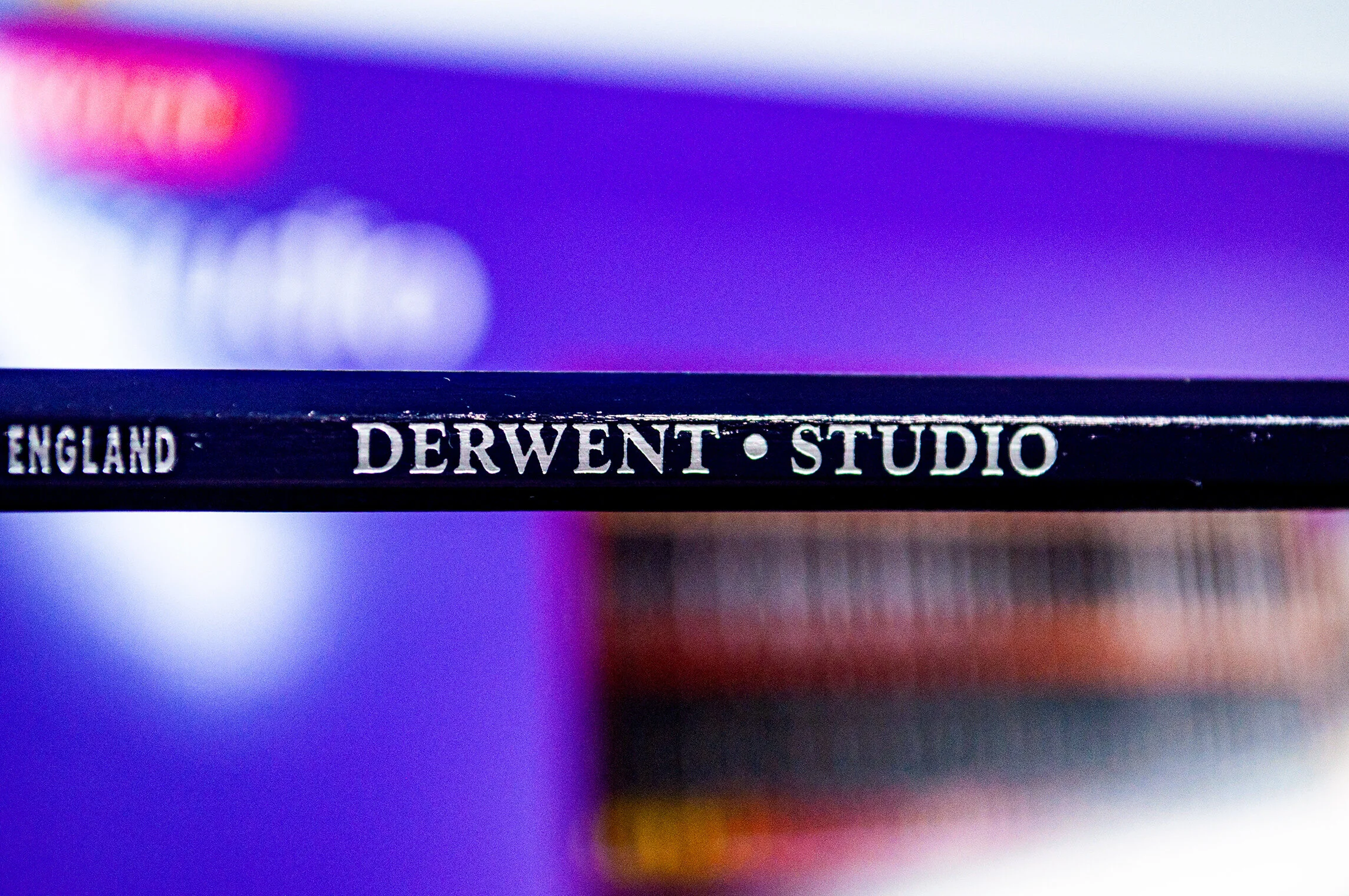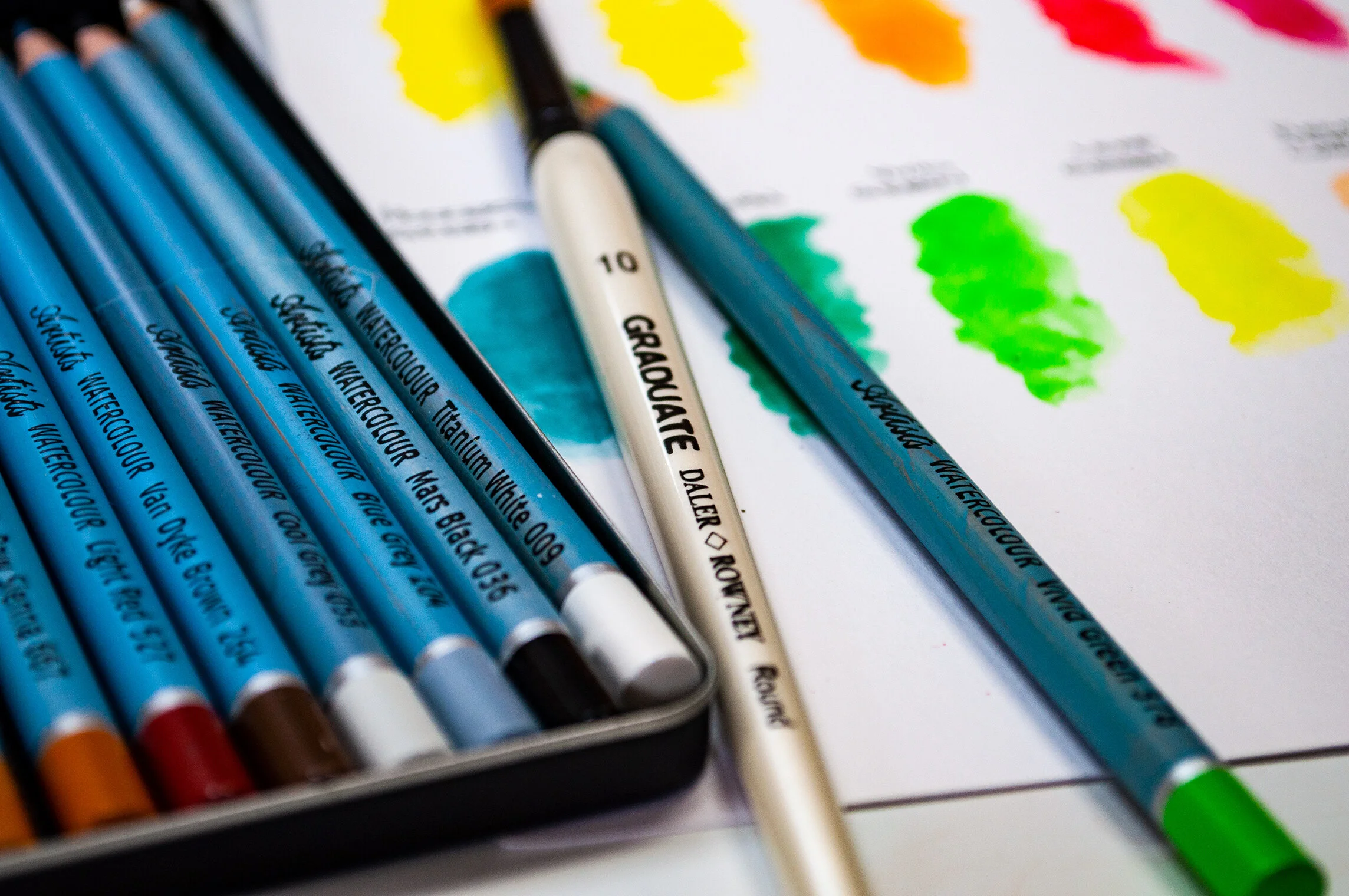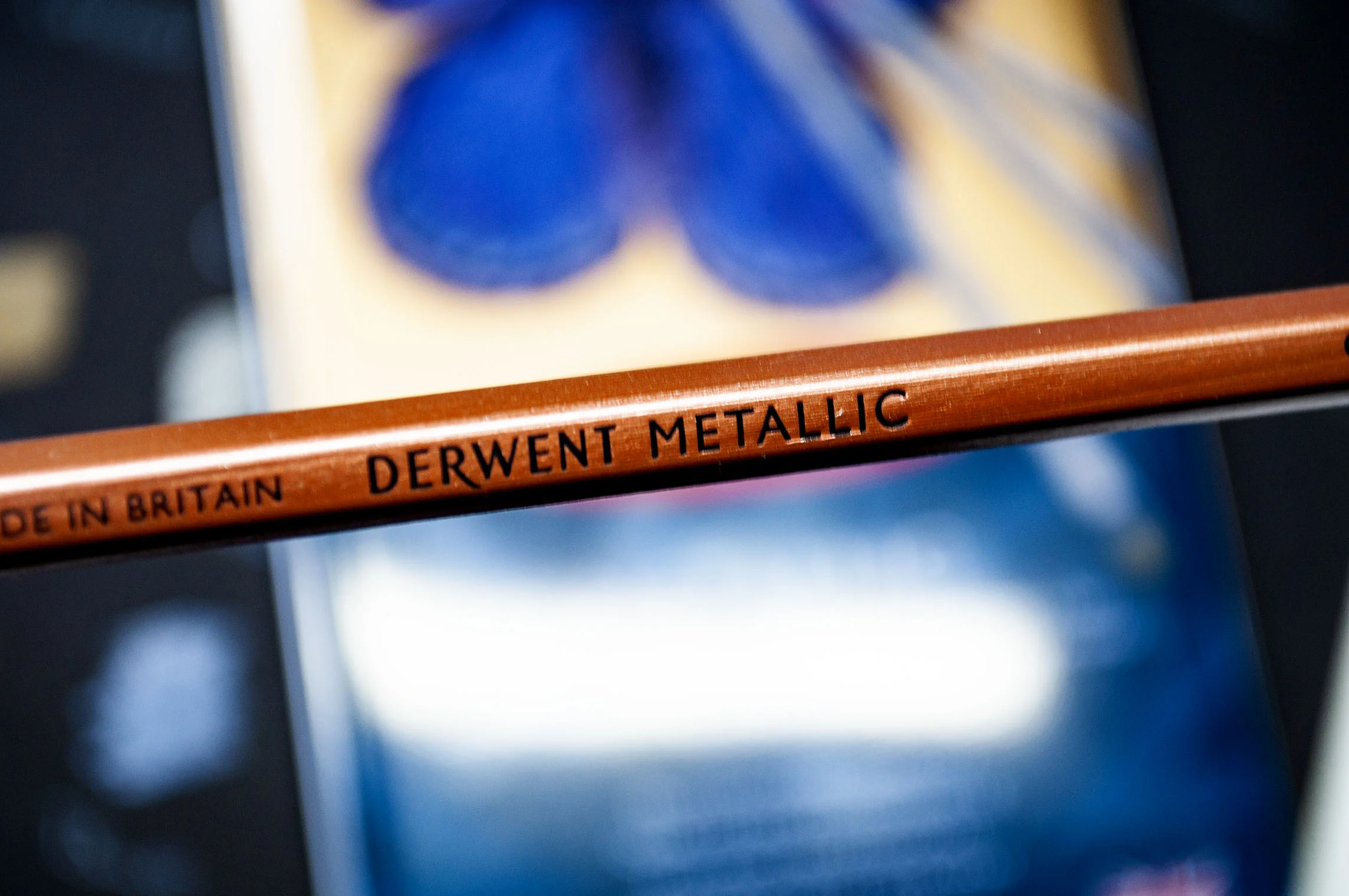Derwent Studio Coloured Pencil Review
Derwent Studio Coloured Pencil Review
One of the first reviews I conducted on this site, back when it was called “Coloured Pencil Reviews”; was the Derwent Studio. Now at the very beginning of my making reviews, I did them more or less as a newbie staggering through the art world and sharing my mistakes, it wasn’t until about six or seven months into the website that I gained enough knowledge to actually start helping others.
Three and a half years on give or take, over 200 reviews and I have learnt such a lot, as a result, I wanted to redo one or two of my very first reviews, primarily to improve the video and audio quality and to add information that I have gained about the product. Also, back in the beginning, my art certainly wasn’t up to displaying online never mind helping to enhance a review, so for those reviews I failed to conduct art with, I will be redoing also.
Of all my first reviews, I think I really gave the Derwent Studio pencil an unfair crack of the whip, I purchased a 24 set back then and so when it came to redoing the review, I only had one or two of the Derwent Studio Pencils remaining. I purchased a 72 Wooden Box Set of the Derwent Studio pencils for the purpose of this review and I am happy to say that I have indeed conducted a piece of art with the Studio pencils.
Derwent Studio Coloured Pencil Characteristics
As I mentioned, I purchased the 72 Wooden Box Set for the purpose of this review, so before I get on to the characteristics of the actual pencils, I just want to highlight an issue I feel or hope Derwent can address with the Wooden Box itself.
In every Wooden Box, there are individual slots for the pencils to be housed and prevent the pencils from moving about in transit. With the Derwent Studio set that I purchased, when it arrived the pencils were all over the place and only the wooden bars stopped the pencils from falling out altogether when I opened the set. From what I can gather, the dimension for all the wooden box sets are the same and that is fine for the thicker barrelled pencils such as the Artist, Coloursoft, ProColour, Lightfast etc. However, the Derwent Studio pencils are considerably thinner than all the other Derwent Pencils and as such, do not fit into the designated slots, there is wiggle room, hence the poor state of the Derwent Studio Coloured Pencils when my set arrived and I opened them. Unfortunately, as soon as the sets leave Derwent, transit conditions are out of their hands and for the most part, postmen or women haven’t got a clue what they are tossing about the warhorses. This being the case and the extra money that is paid for the wooden box sets, I think Derwent should consider making changes to the Derwent Studio Wooden Box Set dimensions. I will display further into the review the damage that can be caused to these pencils if found in the hands of careless transit personnel.
The Derwent Studio core is exactly the same ingredients as that of the Derwent Artist, I mentioned this in my first review of the Derwent Studio which a few people disputed, however as with back then, I had this confirmed by Derwent HQ. It is of course natural that the Derwent Studio and Derwent Artist pencils may feel different when in use, this is simply due to the core and barrel size difference.
The Derwent Studio Core is a thin 3.4mm encased in a slinky 6.9mm hexagonal barrel. In my first review of the Derwent Studio, I indicated that the Studio and Artists were designed to go hand in hand with the Studio lending precision and detail where the Artist may not. I actually don’t feel this is really the case, I think in stating that, I was under stating the Derwent Studio when in fact the Derwent Studio pencil holds its own, it is a fine artist quality pencil that can stand proudly alongside the entirety of the Derwent range.
Along one side of the barrel is the word “England” however, I feel that when I purchased my set of Studio pencils I was sent an older batch, because Derwent have now been awarded the illustrious status of adding “Made in Britain” to their products, so if you purchase a set of Studio you may get either set, it is nothing to worry about.
Further along the barrel is printed the company name followed by the pencil brand, which in this case is “Derwent : Studio”, this is closely followed by the pigment name as well as a number which corresponds to the pigment for open stock purposes. The barrel itself is a dark blue colour and the end of every pencil sports a half inch pigment identifier, separating the barrel and identifier with the iconic Derwent diagonal band.
Derwent Studio Coloured Pencil Sets Available
The Derwent Studio pencil, as with every pencil Derwent create, is available in open stock, which for those of you new to colored pencils, simply means you can purchase an individual pencil when needed. Next is a set of 12 tin set, 24 tin set and 36 tin set, there is a 48 set but this is only available in the Wooden Box set. Finally there is a 72 tin set and a 72 Wooden Box set, meaning that 72 is the largest set available in the Derwent Studio range.
Derwent Studio Coloured Pencil Performance
Knowing what I know now about colored pencil art, the overriding factor as to why my results where terrible with the Derwent Studio Coloured Pencil during my first review was due to the paper I used. If my memory serves me correctly, the paper I used for the testing back then, was a Crawford and Black Sketch book, which for those of you who live in the UK and shopped in a store called The Works, you will know the huge mistake I made. I am not sure is this brand is available elsewhere so I hope you can take my word for it when I say, I made a huge mistake and I apologise profusely to you all.
This time round, I have tested and demonstrated the Derwent Studio Coloured Pencils on various high quality artist grade papers, which I will of course explain as we go along. There are many forms of Coloured Pencil artist which I have observed over the years, two in particular are the artists who use the colors they need and lay down heavy thick application of pigment. The other is the artist who completes lots of layers, blends with OMS ( Odourless Mineral Spirits) or another form of blending and continues to add more layers until they achieve the look they are going for. In my opinion, the Derwent Studio Coloured Pencil is best suited to the artist who likes to layer.
I personally love the Derwent Artist and I have had many conversations with colored pencil artists who just can’t get on with the Artist range and this is primarily due to the lack of pigment and hardness of the core. Despite the Derwent Studio Coloured Pencil being exactly the same ingredients, the Studio does have a slightly softer feel to the core when layering, but that has to do with the thinner structure of the core over the Artists.
The art work I completed with the Derwent Studio Coloured Pencils was done on Fabriano Artistico Extra White 100% Cotton paper, not my usual paper, however, very recently I watched one of the amazing Alan Woollett’s instagram clips were he was using this paper and I loved the look of the results. I decided to try the paper and replicate Alans amazing techniques with the Studio pencils, I still have a long way to go, but I found the combination of Derwent Studio pencils on the Fabriano paper to work incredibly well.
The tough cotton content of the paper allowed for many layers to be place by the Derwent Studio Coloured Pencils thus enhancing the strength of pigments with every layer. I personally am not a fan of using ODM, just my own personal preference, but when it comes to the end of the piece and I want to blend say the background colors I use a pencil blender.
I completed a review of the Derwent Artist pencils a while ago creating an art piece on PastelMat to demonstrate just how strong and vibrant the Artist pigments can be. On this occasion I created a small blending exercise on some UART 320 grade paper which you can see images of below. On the YouTube video I also demonstrate this paper with the Derwent Studio pencils in real time so that you can see, as with the Artist demonstration, the Studio pencils actually contain beautiful pigments.
As always, I conducted a layering test, stopping at five layers and then adding one heavy application, for this test I used Strathmore Mixed Media paper. Another strong paper with amble tooth for the pigments to grip hold off, yet not so much as to detract from detailed work or subtle gradients. As you can see from the image, the pigments do start out quite faint but with additional layers, the pigment veracity is immediately noticeable. Mind you, adding the heavy application absolutely packs a pigmented punch, perhaps not the look a pencil artist may be after given the destruction of tooth and lack of movability once applied, nevertheless, I think the demonstration speaks for itself.
I always add a sample of pigments on Black paper and I have to say, the Derwent Studio test on Black paper really surprised me. The aim of this exercise is to demonstrate the translucency or opaqueness of the pigments and quite often during the test with other pencil sets there is a mixture of such results. I really expected the Derwent Studio Coloured Pencils to sway more toward the translucency side of the spectrum, though as you can see, the colors are thick and a pleasing level of opaqueness including the white which really shocked me. Derwent are known to produce some of the most opaque white colored pencils in the form of the Derwent Drawing Chinese White, but I really didn’t expect similar results with the Studio.
As you can see from the artwork I have completed, the Derwent Studio pencils blended well, allowing the colors to fuse into one creating seamless gradients. The thin core of the Studio and slinky barrel certainly helped allow for precision detailed work when it came to the feathers. However, the opposite was true when it came to the background, with the Studio pencils laying down consistently strong pigments.
I mentioned at the beginning of the review the fault with the box sets and the dimensions not right for the thinner Derwent Studio pencil. As you can see from the image below, this is the type of issues that can occur when pencils are not secure during transit and I feel on this occasion, this has been a direct result from the pencils moving about when moved from place to place.
I did come across two pencils that were quite dramatically off centred cores, which all pencil artists know the problems this can cause. Of the 72 pencils finding two in this state is not bad and I will go one step further and say that of all the Derwent pencils I have tested, reviewed and used, of which there has been hundreds, I have never found such badly off centred cores as the two pencils in this set.
Derwent Studio Lightfast Rating
The lightfast ratings overall on the Derwent Studio Coloured Pencils are not the best. Derwent use the Blue Wool scale for their Studio range and that is a scale 1-8. Any pigments rated 6 and over are considered Highly lightfast and will not fade for 100 plus years.
The scale is as follows 7 - 8 = Excellent / 5 -6 = Good to Very Good / 3 - 4 = Fair to Moderate / On the Derwent scale there is nothing listed for 1 - 2 but I should imagine that is Bad.
Taking this scale into consideration, of the 72 pigments in the Derwent Studio range, 14 pigments are rated 7 -8, 5 pigments are rated 5 - 6, 41 pigments are rated 3 -4 and 12 pigments are rated 1 -2. Using this scale only 19 pigments will last 100 Plus years
However, of the 72 pigments, 57 are Vegan friendly which I know will please a considerably growing population. As more and more people turn to vegetarianism or Vegan, companies are becoming much more aware and are trying to help cater to this noble cause which I think shows fantastic willing to embrace change on behalf of companies like Derwent.
Derwent Studio Coloured Pencil Pricing
As with so many art products, to head directly to the companies web store for purchasing may see you spend a little bit more money than you may want.
Here in the UK you can expect to pay the following for a set of the Derwent Studio Coloured Pencils. For the 12 set of Derwent Studio Coloured Pencils you will pay £16.25, for the 24 set £32.29 , for the 36 set £45.50 , for the 48 Wooden Box set £69.99, for the 72 set £96 and for the 72 Wooden Box set £111
For some rather bizarre reason, I was able to locate every single pencil Derwent sell on the US Amazon store, except the Derwent Studio Coloured Pencils, so for this review only I have used Dick Blicks pricing guide, I was unable to locate these pencils in Jerrys as well. For the 12 Tin set you can expect to pay $22.63, for the 24 set you will pay approx $42.30, for the 36 Set $55.99, for the 72 Tin set $119.93 and for thr 72 Wooden Box Set you can expect to pay approximately $143. I was unable to locate a price for the 48 Wooden Box set but don’t forget this is just a guideline for prices in the US, I was unable to get lower prices on Amazon so make sure you check out all your local stores as well.
In Europe for the 12 set of Derwent Studio you will pay approximately €23, for the 24 set you will pay €50, for the 36 set you will pay €67, for the 48 Wooden Box set you will pay €105, for the 72 tin set you will pay €132 and for the 72 Wooden Box set you will pay €129. I know the Wooden Box set in the 72 line is cheaper than the tin, but that is just sometimes the case if there is a deal.
Derwent Studio Coloured Pencil Conclusion
Armed with the right information, a little bit of extra knowledge, an awesome teacher in the way of Alan Woollett, the understanding of paper importance, what a difference it makes to a pencil. It was about six or seven months into my reviews that I started to realise and understand there is not really any such thing as a bad pencil, it is just a matter of making sure you have the right paper and subject to paint with that particular pencil.
I often hear artist stress the importance of paper and it is so incredibly true and when you think of it, all these paper companies invest years of research and money into refine their papers; if paper didn’t have such a profound effect on a product, companies wouldn’t waste all that time and money.
This time round, with the right paper, the right layering techniques and the patient’s it takes to add layer after layer after layer, I thoroughly enjoyed using the Derwent Studio Coloured Pencils and I have to say that I am very pleased with the outcome of my artwork demonstration.
If you would like to read my first review of the Derwent Studio Coloured Pencils or watch the YouTube video review, just follow the links, however, I have to warn you, the video quality is terrible.
If you would like to see the YouTube video review to accompany this review, follow the links or to watch the speed drawing of the artwork follow the links. I have also added a page on The Art Gear Guide where you can click on images I have taken of the art work at various stages of completions and inspect the pigments at your own leisure.
don’t get me wrong, the Derwent Studio Coloured Pencils are not every pencil artists cup of tea, but no pencil is perfect for everyone. The lightfast ratings are not the best and I would like to see Derwent sort out the Wooden Box set dimension. Apart from these small issues, I think the Derwent Studio Coloured Pencil is a solid pencil. Thank you all so much for your amazing support, wonderful comments, touching emails and above all excellent friendships.















